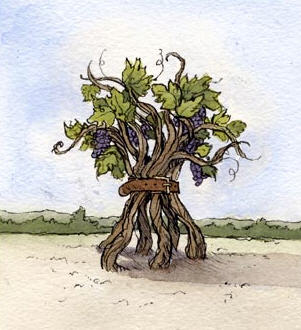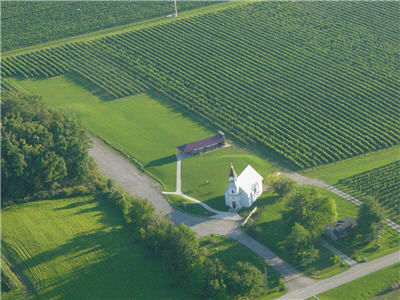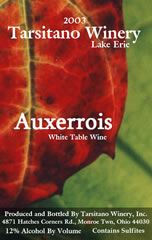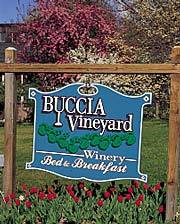

Once a leader in the wine industry, Ohio has a David vs. Goliath fight for attention on its hands.
Ohio’s Lake Erie AVA Has a Corner of the Wine Market
by
Eleanor & Ray Heald
July 29, 2009
 lthough Ohio’s wineries are scattered around the state, Ashtabula County in the Lake Erie AVA has developed as the wine capital of Ohio. Many wineries are located in the cool climate winegrowing region, an hour east of Cleveland, one and a half hours from Pittsburgh and about a half mile from the Lake Erie shoreline. Markko Vineyard owner Arnie Esterer suggests “western reserve” as a name to distinguish the Ohio portion of the Lake Erie AVA.
lthough Ohio’s wineries are scattered around the state, Ashtabula County in the Lake Erie AVA has developed as the wine capital of Ohio. Many wineries are located in the cool climate winegrowing region, an hour east of Cleveland, one and a half hours from Pittsburgh and about a half mile from the Lake Erie shoreline. Markko Vineyard owner Arnie Esterer suggests “western reserve” as a name to distinguish the Ohio portion of the Lake Erie AVA.
Within California, there’s growing controversy about the term cool climate growing region. So, let’s leave this state out of the mix here and consider most regions of northern France, Austria, Germany, Oregon, some sectors of
 Washington state, and most vineyards east of the Mississippi River. These areas have a shorter growing season, colder winters and highly unpredictable spring and autumn weather patterns.
Washington state, and most vineyards east of the Mississippi River. These areas have a shorter growing season, colder winters and highly unpredictable spring and autumn weather patterns.
Considering these climatic factors, only certain vinifera grape varieties reach full ripeness (at lower alcohols between 12 and 14 percent), among them Pinot Gris, Pinot Blanc, Riesling and Gewurztraminer. Also count in Chardonnay with a more aromatic, fruitier and crisper profile. And for red wine, Cabernet Franc has proven itself as an earlier ripening variety with raspberry aromatics and a lush and plush mouthfeel – think Chinon style from the Loire Valley. Some producers are having success with Pinot Noir.
Beginning in the early 1970s in the “western reserve,” vinifera varieties jumped to the forefront ahead of winter-hardy hybrids. Significant strides have been made to reduce vinifera vine winter kill and extend the growing season through new clonal selections, rootstock choices, vine trellis and canopy management control, the latter pioneered by Arnie Esterer of Markko Vineyard.
Aside from severe winters along the Lake Erie AVA “strip,” warm Lake Erie breezes make Ashtabula County a good grape growing location. In addition to this commonality, wineries in the county have followed dissimilar routes to bring attention to their wines, yet work together to make the finest wines possible. Some believe that the best way to your heart is through your stomach and have restaurants or cafes. Others want well-rested and pampered tasters, so they invite stays in their B&B.
In the town of Conneaut, in the most northeastern sector of Ohio’s Lake Erie AVA, three wineries literally have the corner on Ohio wines.
Winemaker Ken Tarsitano considers that Tarsitano Winery traces a history back to the late 1800s and his Finnish great grandfather. Modern era began in 1996 when this Cleveland suburbs native with an Ohio State University (OSU) degree in psychology and
 philosophy, who worked in an ad agency after graduation, found himself back on the family farm. He struggled to earn a living as a certified (1998 by Ohio Ecological Food & Farming Association) organic fruit, nut and vegetable farmer before he realized that the parcel with heavy clay and crustacean deposits could grow fine wine grapes.
philosophy, who worked in an ad agency after graduation, found himself back on the family farm. He struggled to earn a living as a certified (1998 by Ohio Ecological Food & Farming Association) organic fruit, nut and vegetable farmer before he realized that the parcel with heavy clay and crustacean deposits could grow fine wine grapes.
“Here begins the chapter,” Tarsitano says, “where the Italian half of my family enters the wine picture. My grandfather Michael Tarsitano made amateur wine in his home cellar. If it could be made into wine he taught me how. I took a job at the OSU Grape Research Center and learned how to grow wine grapes. Fred Bucci (Buccia Vineyard), Nick Ferrante (Ferrante Winery), and Joe Biscotti (Biscotti Winery) influenced my winemaking techniques. However, it was Arnie Esterer from Markko Vineyard, who had the greatest impact on my wine style.? He counseled me to let the vineyard speak for itself; showcase each vintage; and make wine in small lots using only neutral to new American and French oak cooperage for fermentation.
“I planted the first vines in 1999. In 2000, I bought my first grapes from the Research Center. The only press I had was my grandfather’s screw press. Luckily, Fred Bucci offered to help me if I helped him press his grapes. Arnie Esterer told me to go pick some of his Chardonnay, and grower Dave Genger (South Ridge Vineyards) offered some of his Cabernet Sauvignon. The next thing I knew I had 1,500 gallons in my cellar, anything over 200 is illegal. So, I dealt with the ATF, TTB, State Liquor Control, lawyers and accountants and became a bonded facility.”
Tarsitano opened for commercial business in 2001, even though this wasn’t in the master plan till 2005. For a current production of somewhat more than 2,500 cases (slated to grow three fold in three years when the vineyard is in full production) there are now 25 wine grape varieties and 17 acres of planted vines, including the whites Auxerrios, Chardonnay, Gewürztraminer, Pinot Gris, and Riesling. Among red varieties are Cabernet Franc (seven clones on six different rootstocks), Cabernet Sauvignon and Pinot Noir.
Travel frustration gave rise to, proprietors Joanna and Fred Bucci’s small Buccia Vineyard producing about 1,700 cases annually. Fred desired another lifestyle when he got tired of winter (think snow) travel roundtrip to his Cleveland office. Taking advice from Esterer, Doug Moorhead (Presque Isle
 Wine Cellars, PA) among others, he rose from the ranks of amateur winemaker to planting the current 4.5-acre vineyard, with sandy top soil and gravel subsoil, beginning in 1975 including Baco Noir, Seyval, Vignoles and Steuben.
Wine Cellars, PA) among others, he rose from the ranks of amateur winemaker to planting the current 4.5-acre vineyard, with sandy top soil and gravel subsoil, beginning in 1975 including Baco Noir, Seyval, Vignoles and Steuben.
Fred’s interest in change-of-pace wines led him in early 2000 to Agawam, a light red skinned hybrid of vitis labrusca x vitis vinifera that he cold presses to make a white wine, described as “fruity entry with an herbal, spicy finish. We may be the only domestic grower of this variety. It has characteristics of a Niagara, Delaware, Muscat and Gewurztraminer blend.” Then there’s Zweigelt of Austrian heritage, but sourced from OSU research cuttings, which is bottled varietally as a full-bodied, mellow, berry rich red.
The Buccis have found success with winter-hardy hybrids which has lessened concerns about winter vine kill.
Although he shuns the “pioneer” moniker, Markko Vineyard’s proprietor/winemaker Arnie Esterer is one. Just ask any Ohio winemaker or grape grower! “My late partner Tim Hubbard and I,” Esterer begins, “had guidance from Dr. Konstantin Frank (Vinifera Wine Cellars, NY) as we were finding our way in founding Markko Vineyard in 1968.” Now, Markko is recognized as the first Ohio winery to seriously attempt to grow vinifera grapes, in particular Riesling and Chardonnay, in the Lake Erie AVA. “Dr. Frank told me, Esterer notes, “if he could grow vinifera varieties in Russia, I could grow them in northeast Ohio.”
Esterer left a 17-year career as an industrial engineer. “Somehow,” he explains, “I transformed from a desk-boun










 READER FEEDBACK: To post your comments on this story,
READER FEEDBACK: To post your comments on this story,



